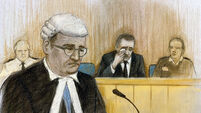Sun, 14 Dec, 2003 - 14:14
A glance at the life of former Iraqi President Saddam Hussein:
April 28, 1937 – Born in village near desert town of Tikrit, north of Baghdad.
Already a subscriber? Sign in
You have reached your article limit.
Subscribe to access all of the Irish Examiner.
Annual €130 €80
Best value
Monthly €12€6 / month
Introductory offers for new customers. Annual billed once for first year. Renews at €130. Monthly initial discount (first 3 months) billed monthly, then €12 a month. Ts&Cs apply.
CONNECT WITH US TODAY
Be the first to know the latest news and updates
CourtsSaddam HusseinPlace: TikritPlace: BaghdadPlace: SyriaPlace: EgyptPlace: HalabjaPlace: KuwaitPlace: JordanPlace: IraqPlace: United Arab EmiratesPlace: United StatesPlace: Dora FarmsPlace: MansurPlace: MosulPlace: AdwarPerson: Saddam HusseinPerson: presidentPerson: GenPerson: Abdel-Karim KassemPerson: SaddamPerson: KassemPerson: Ahmed Hassan al-BakrPerson: President George BushPerson: BushPerson: QusaiPerson: OdaiPerson: RaghadPerson: RanaPerson: King Abdullah II.Person: Maj Gen Ray OdiernoEvent: Arab League summitOrganisation: Baath Socialist PartyOrganisation: BaathOrganisation: BaathistsOrganisation: Revolutionary Command CouncilOrganisation: BakrOrganisation: KuwaitOrganisation: UNOrganisation: Security CouncilOrganisation: United NationsOrganisation: IraqOrganisation: SpainOrganisation: BritainOrganisation: USOrganisation: US troopsOrganisation: US 4th Infantry Division














